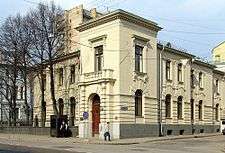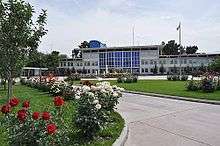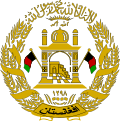Afghanistan–Russia relations
 | |
Afghanistan |
Russia |
|---|---|
| Diplomatic Mission | |
| Afghani Embassy, Moscow | Russian Embassy, Kabul |


Afghanistan–Russia relations (Russian: Российско-афганские отношения) refers to the relations between the nations of Afghanistan and Russia. These relations are independent of the "Great Game" which consists of Russian-British confrontations over Afghanistan since 1840.[1]
Relations were strained by Soviet Russia's invasion of Afghanistan in 1979. This invasion precipitated a negative reaction in most of the Muslim world, contributing to a decline in Afghanistan's prosperity and a strengthening of radical elements within the country. However, Russo-Afghan relations have improved somewhat in the years following the conflict. Russia now has an embassy in Kabul and a consulate-general in Mazar-e-Sharif, and Afghanistan has an embassy in Moscow.
Historical relations
Czarist Russia
Czarist Russia first established diplomatic relations with Afghanistan in 1837, at a time of strained diplomatic relations between Great Britain and Russia.[2] Imperial Russia desired a direct trading route with India. Initial contact with Afghanistan was viewed with suspicion by the British Empire, which suspected Russia of attempting to expand its territory into the Indian subcontinent. The Russian government opened diplomatic relations with Afghanistan. This, combined with their support of Iranian ruler Mohammad Shah Qajar's attempt to conquer Herat in 1838, resulted in the British invasion of Afghanistan during the First Anglo-Afghan War (1839–42).
Throughout the 19th century Russia steadily advanced across Central Asia, conquering Tashkent in 1865, Samarkand and Kokand in 1868, and Khiva in 1873. Britain suggested Afghanistan as a buffer state, but following the June 1878 Congress of Berlin Russia sent a diplomatic mission to Kabul.[3] Sher Ali Khan, the Amir of Afghanistan, attempted to keep the Russian envoys out, but they arrived in Kabul on 22 July 1878. On 14 August, the British demanded that Sher Ali accept a British mission as well.[4] This incident resulted in the Second Anglo-Afghan War.
The Panjdeh incident in 1885 was the next major event in the history of Afghan-Russian relations. Once again, the British-Russian rivalry boiled over after Russia seized several oases from Afghanistan. The British threatened war, but the nations made an agreement in 1887 establishing a buffer zone in Central Asia.[5]
The 1916 anti-Russian rioting in Turkistan led to the Basmachi movement, which received some support from the Afghan government. The Basmachi rebels used parts of Afghanistan as a safe haven until the Bolshevik Revolution of 1917, when Vladimir Lenin and other communist party leaders made efforts to gain support from the considerable Muslim population of their country.[6] In the wake of World War I, the Bolsheviks were occupied with the Russian Civil War and other domestic issues, so Russia was less threatening compared to British imperialism. In 1919, Britain invaded for a third time in the Third Anglo-Afghan war. Soviet Russia indirectly supported Afghanistan during the war by becoming the first country to establish diplomatic relations with them in 1919, and recognizing their borders.[7] A British attempt to assassinate the Afghan premier, Amanullah Khan, in June 1920 led to Afghanistan quickly signing a draft of an Afghan-Soviet nonaggression pact which was formalized in 1921.[8] The treaty provided for Afghan transit rights through the Soviet Union and formed the basis of friendly relations during the 1920s. Early Soviet assistance included financial aid, aircraft and attendant technical personnel, and telegraph operators. During Amanullah Khan's visit to Moscow in 1928 he was greeted as a close friend of the still diplomatically isolated Soviet Union.
The USSR

The Cold War spanned the 1950s to the 1990s. The conflict shaped Russian foreign policy towards developing countries, emphasizing the creation of puppet, proxy, and buffer states.
At the beginning of Soviet intervention in Afghanistan in 1953, the Soviets' long term objectives were to threaten the Iranian oilfields, strengthen their influence in the Indian subcontinent, and divert western military resources to an unproductive area of the world.
Leading up to the Soviet intervention, Afghanistan's foreign policy was non-alignment. Despite this policy, the Afghanistan government still retained good terms with both the United States and the Soviet Union. In 1958, Afghanistan's prime minister Daoud Khan tried to create a treaty with America against the Soviet Union because he was frightened of a potential Soviet invasion and because he needed modern weapons. After the United States turned down the Afghanistan government, Afghanistan asked the USSR for aid in 1956. With this agreement, the Soviet Union provided financial aid, military personnel training, and modern weapons (such as AK-47s and rocket launchers). Daoud was forced to resign in 1963 because of the dependence that he had created on the Soviet Union. After his brief resignation from office, he led a coup that toppled the Soviet's puppet regime in Afghanistan, returning him to power. To counteract his previous mistakes, Daoud led Afghanistan back towards independence and non-alignment. Additionally, he sent troops as well as diplomats to neighbouring countries to build up foreign relations and decrease Afghanistan's dependence on the Soviet Union.
There were four main motivations for the Soviet invasion of Afghanistan in 1979. First, the Soviet belief that Afghanistan had strategic importance for the security of their borders. This belief was consistent with longstanding Russian foreign policy that emphasized security through expansionism and the establishment of physical barriers in the form of buffer states. The second reason for invasion was the possibility of interrupting Chinese and American efforts to establish greater political influence in Afghanistan before Soviet intervention would entail direct confrontation of those two rival powers. The third reason was to enforce the dominance of Marxist–Leninist revolutionary ideals, above the emergent Nationalist Islamic ideology in Afghanistan. Lastly, the Soviets were not above the imperial advantages of direct intervention and occupation. In particular, they were interested in securing unfettered access to the raw materials and inexpensive manufactured goods of their smaller neighbour. Around this time, the Soviets were also experiencing success in influencing affairs in the Middle East, such as the southern part of the Arabian Peninsula. The invasion earned the Soviet Union almost universal condemnation by the international community.[9]
The Soviets began a major economic assistance program in Afghanistan in the 1950s.[10] Between 1954 and 1978, Afghanistan received more than $1 billion in Soviet aid, including substantial military assistance. In 1973, the two countries announced a $200 million assistance agreement on gas and oil development, trade, transport, irrigation, and factory construction. Following the 1979 invasion, the Soviets augmented their large aid commitments to shore up the Afghan economy and rebuild the Afghan military. They provided the Karmal regime an unprecedented $800 million. The Soviet Union supported the Najibullah regime even after the withdrawal of Soviet troops in February 1989. Today, unresolved questions concerning Soviet MIA/POWs in Afghanistan remain an issue between Russia and Afghanistan.
The Russian Federation
In 1993, Tajik rebels based in Afghanistan attacked a Russian border outpost in Tajikistan, killing 25 Russians and prompting Russian retaliatory strikes,[11] which caused extensive damage in northern Afghanistan. Reports of Afghan support for the Tajik rebels led to cool relations between the two countries.
Russia became increasingly disenchanted with the Taliban over their support for Chechen rebels and for providing a sanctuary for terrorist groups active in Central Asia and in Russia itself. Russia provided military assistance to the Afghan Northern Alliance, who eventually proved to be a major force in the efforts to overthrow the Taliban regime following United States intervention in 2001.
In October 2005, Russian defence officials stated they would be giving helicopters and other military equipment to Afghanistan's army worth $30 million USD.[12]
In October 2010, Afghan President Hamid Karzai reprimanded Russia after its forces entered the country without permission. He also stated that Russia has "violated Afghan sovereignty" in a joint mission with United States agents.[13]
However, after Russia's relations with the West soured following the Ukraine conflict, Moscow decided to become active and expand its role in Afghanistan, according to Omar Nassar, the director of the Moscow-based Center for Contemporary Afghan Studies (CISA).[14]
In an exclusive interview with Sputnik news agency, former IRA President Hamid Karzai said: "Our two countries have very close ties now. Russia as a neighboring country, with which we have long historical ties and traditionally friendly relations, can contribute to the peace process, and we believe that friendship with Russia will become an important factor of stability and sustainable development of our country." [15]
Russia's more active involvement in Afghanistan includes business investment proposals, diplomatic propaganda, cultural programs, financial and military support for the central government, power influence in the north and with the Taliban. In 2014, it re-opened a cultural center in Kabul. Since 2016, it has provided the Afghan government with tens of thousands of Kalashnikov rifles and millions of rounds of ammunition.[16] Moscow has already launched several efforts at diplomacy. Between December 2016 and April 2017, Russia hosted three rounds of talks involving China, Iran, and Pakistan. In the third round, it included Afghanistan, as well.[17]
References
- ↑ Rodric Braithwaite. "The Russians in Afghanistan." Asian Affairs 42.2 (2011): 213-229 summarizes the long history.
- ↑ The Soviet Union and the Muslim World 1917-1958, University of Washington Press, Seattle, 1959
- ↑ Medlicott and Weeks Jr., W. N and Richard G. (January 1986). "Documents on Russian Foreign Policy, 1878-1880: Section I: August-December 1878". The Slavonic and East European Review. 64: 81–99 – via JSTOR.
- ↑ Barthorp, Michael (2002) [1982]. Afghan Wars and the North-West Frontier 1839–1947. London: Cassell. pp. 66–67. ISBN 0-304-36294-8.
- ↑ Raymond Mohl, "Confrontation in Central Asia" History Today 19 (1969) 176-183
- ↑ The Soviet Union and the Muslim World 1917-1958, University of Washington Press, Seattle, 1959
- ↑ Amin Saikal, Ravan Farhadi, Kirill Nourzhanov. Modern Afghanistan: a history of struggle and survival. I.B.Tauris, 2006. ISBN 1-84511-316-0, ISBN 978-1-84511-316-2. Pg 64
- ↑ Khalid, Iram (Winter 2011). "Afghanistan: Quest for Peace and Stability". Journal of Political Studies. 18: 1–16 – via ProQuest.
- ↑ Garg, J. P.. 1981. “Russian penetration in Third World with special reference to Afghanistan”. The Indian Journal of Political Science 42 (4).: 72–84.
- ↑ Payind, Alam (1989). "Soviet-Afghan Relations from Cooperation to Occupation". International Journal of Middle East Studies. 21 (1): 107–128. JSTOR 163642.
- ↑ Reuters. "45 Reported Killed in a Clash in Tajikistan". Retrieved 2018-07-05.
- ↑ "Tourists flee devastated flood area". Chicago Tribune. 10 October 2005. Retrieved 27 December 2014.
Russia will supply Afghanistan's fledgling army with helicopters and equipment worth $30 million
- ↑ Los Angeles Times - Karzai denounces drug raid in Afghanistan
- ↑ Nazimi, Waslat Hasrat. "Russia's new role in Afghanistan".
- ↑ Sidikov, Ramil. "EXCLUSIVE: Karzai Says 'Afghanistan Can't Build Relations Based on US Interests'".
- ↑ Gurganus, Julia (2018). "Russia's Afghanistan Strategy".
- ↑ Gurganus, Julia (2018). "Russia's Afghanistan Strategy".
Further reading
| Wikimedia Commons has media related to Afghanistan - Russia relations. |
- * Adamec, Ludwig W. Afghanistan's foreign affairs to the mid-twentieth century: relations with the USSR, Germany, and Britain (University of Arizona Press, 1974).
- Bagchi K.P. Soviet Afghan relations (the University of Michigan, 1985)
- Braithwaite, Rodric. "The Russians in Afghanistan." Asian Affairs 42.2 (2011): 213-229 summarizes the long history.
- Braithwaite, Rodric. Afgantsy: The Russians in Afghanistan 1979-89 (Oxford University Press, 2013)
- Brysac, Shareen and Karl Meyer. Tournament of Shadows: The Great Game and the Race for Empire in Central Asia. (2006).
- Dalrymple, William. Return of a King: The Battle for Afghanistan, 1839-1842 (Alfred Knopf, 2013).
- Girardet, Ed. Afghanistan: The Soviet War (Routledge, 2012).
- Honnen, Mark F., "Securitizing British India: A New Framework of Analysis for the First Anglo-Afghan War." (MA Thesis, Georgia State University, 2013. online bibliography pp 100=103.
- Hopkirk, Peter. The great game: The struggle for empire in Central Asia (Kodansha Globe, 1994).
- McCauley, Martin. Afghanistan and central Asia: A modern history (Routledge, 2016).
- Yapp, M.E., Strategies of British India: Britain, Iran, and Afghanistan, 1798-1859 (1980).


